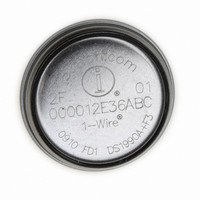DS1922T-F5# Maxim Integrated Products, DS1922T-F5# Datasheet - Page 29

DS1922T-F5#
Manufacturer Part Number
DS1922T-F5#
Description
IBUTTON TEMP LOGGER
Manufacturer
Maxim Integrated Products
Series
iButton®r
Datasheet
1.DS1922L-F5.pdf
(52 pages)
Specifications of DS1922T-F5#
Rohs Information
IButton RoHS Compliance Plan
Memory Size
512B
Memory Type
NVSRAM (Non-Volatile SRAM)
Lead Free Status / RoHS Status
Lead free / RoHS Compliant
corresponding ending offset in this example is 1Fh. For
best economy of speed and efficiency, the target
address for writing should point to the beginning of a
page, i.e., the byte offset is 0. Thus, the full 32-byte
capacity of the scratchpad is available, resulting also in
the ending offset of 1Fh. The ending offset together with
the PF flag are a means to support the master checking
the data integrity after a Write command. The highest
valued bit of the E/S register, called authorization
accepted (AA), indicates that a valid Copy command
for the scratchpad has been received and executed.
Writing data to the scratchpad clears this flag.
To write data to the DS1922L/DS1922T, the scratchpad
must be used as intermediate storage. First, the master
issues the Write Scratchpad command to specify the
desired target address, followed by the data to be writ-
ten to the scratchpad. In the next step, the master
sends the Read Scratchpad command to read the
scratchpad and to verify data integrity. As preamble to
the scratchpad data, the DS1922L/DS1922T send the
requested target address TA1 and TA2 and the con-
tents of the E/S register. If the PF flag is set, data did
not arrive correctly in the scratchpad. The master does
not need to continue reading; it can start a new trial to
write data to the scratchpad. Similarly, a set AA flag
indicates that the Write command was not recognized
by the device. If everything went correctly, both flags
are cleared and the ending offset indicates the address
of the last byte written to the scratchpad. Now the mas-
ter can continue verifying every data bit. After the mas-
ter has verified the data, it must send the Copy
Scratchpad command. This command must be fol-
lowed exactly by the data of the three address registers
TA1, TA2, and E/S, as the master has read them verify-
ing the scratchpad. As soon as the DS1922L/DS1922T
have received these bytes, they copy the data to the
requested location beginning at the target address.
______________________________________________________________________________________
Temperature Logger iButton with 8KB
Writing with Verification
Figure 9 shows the protocols necessary for accessing
the memory and the special function registers of the
DS1922L/DS1922T. An example on how to use these
and other functions to set up the DS1922L/DS1922T for
a mission is included in the Mission Example: Prepare
and Start a New Mission section. The communication
between the master and the DS1922L/DS1922T takes
place either at standard speed (default, OD = 0) or at
overdrive speed (OD = 1). If not explicitly set into the
overdrive mode the DS1922L/DS1922T assume stan-
dard speed. Internal memory access during a mission
has priority over external access through the 1-Wire
interface. This affects several commands in this sec-
tion. See the Memory Access Conflicts section for
details and solutions.
After issuing the Write Scratchpad command, the mas-
ter must first provide the 2-byte target address, fol-
lowed by the data to be written to the scratchpad. The
data is written to the scratchpad starting at the byte off-
set T[4:0]. The master must send as many bytes as are
needed to reach the ending offset of 1Fh. If a data byte
is incomplete, its content is ignored and the partial byte
flag PF is set.
When executing the Write Scratchpad command, the
CRC generator inside the DS1922L/DS1922T calculates
a CRC of the entire data stream, starting at the com-
mand code and ending at the last data byte sent by the
master (Figure 15). This CRC is generated using the
CRC-16 polynomial by first clearing the CRC generator
and then shifting in the command code (0Fh) of the
Write Scratchpad command, the target addresses TA1
and TA2 as supplied by the master, and all the data
bytes. If the ending offset is 11111b, the master can
send 16 read time slots and receive the inverted CRC-
16 generated by the DS1922L/DS1922T.
Note that both register pages are write protected dur-
ing a mission. Although the Write Scratchpad command
works normally at any time, the subsequent copy
scratchpad to a register page fails during a mission.
Data-Log Memory
Function Commands
Memory and Control
Write Scratchpad [0Fh]
29












